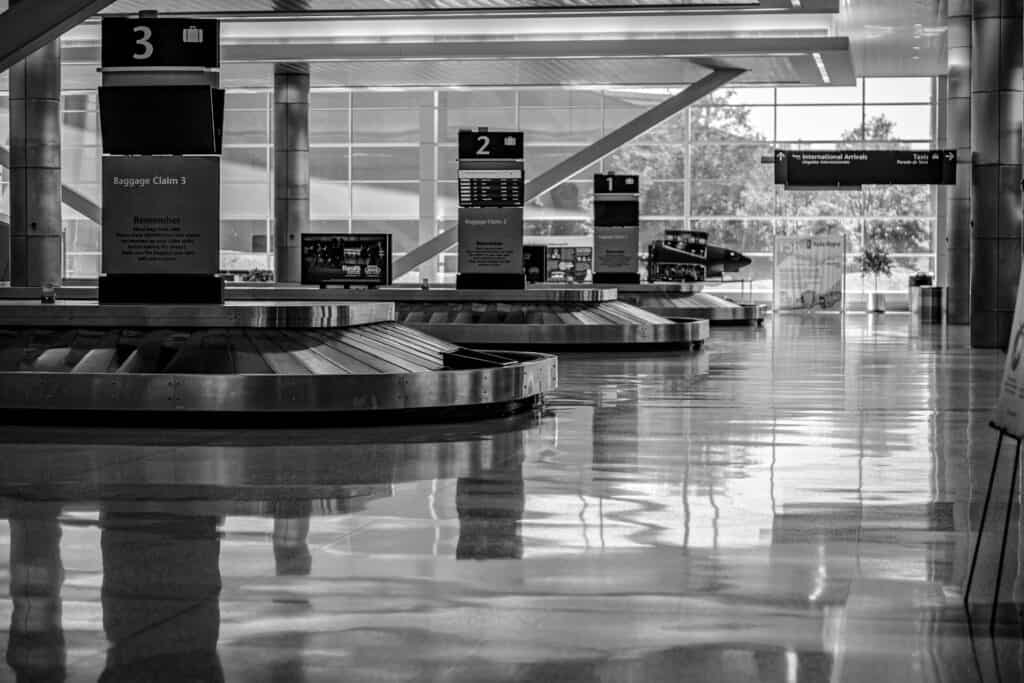How to Fly with golf clubs: airlines Tips and more (2024)
By: Scott Brera | Last Updated April 16, 2024

Excited about the golf trip but nervous about bringing your clubs? From packing mishaps to hidden airline fees, traveling with golf clubs can be stressful. In this article, we’ll share our top tips on how to fly with golf clubs like a seasoned pro and help ensure your clubs arrive safely to your destination unscathed.
Key Takeaways
- Invest in a travel bag/case to protect your clubs during flight.
- Check airline baggage policies on golf clubs and weight limits to ensure you aren’t hit with a hefty fee at the airport.
- Try not to overpack (will reduce weight and limit risk of damaging clubs).
Airport and Airline Tips
Below are three tips for traveling when at the airport or booking the flight:
1. Navigating Airline Policies: Baggage Fees, Weight Limits, Etc.
It is important to familiarize yourself with the baggage policies of the airlines you’ll be flying with to avoid unexpected fees or issues at the airport. Many have specific guidelines and fees for transporting golf clubs, which can vary widely depending on the carrier and your destination. Some airlines may include the transport of a golf bag as part of your standard checked baggage allowance, while others may charge additional fees, especially for oversized or overweight bags. Check the airline’s website or contact their customer service directly to inquire about their specific policies regarding golf club transportation and any associated fees. In short, read the fine print.
In addition to baggage fees, it’s also crucial to be aware of weight limits, as exceeding these limits can result in hefty additional charges. While standard checked baggage allowances are typically around 50 pounds per bag, sports equipment like golf bags may have different weight restrictions or incur overweight fees if they exceed the airline’s limit. Be sure to weigh your golf bag and any other luggage you plan to check before arriving at the airport to avoid surprises. If your bag exceeds the weight limit, consider redistributing items among your other bags or opting to pay for additional weight allowance if available, to avoid costly fees and delays at check-in.
Airline Policy Summaries (as of April 2024)
- Southwest: Golf bag allowed as one of your two free checked bags if they are within the weight limit. Hard case required (or sign limited release if soft shell). Can only contain clubs, balls, and shoes.
- American: Golf bag allowed, cost of standard checked bag fees of your destination, up to 50 pounds. Bag can only contain golf clubs, golf balls, golf tees, and one pair of golf shoes.
- United: Golf bag allowed as a checked bag and must be in a hard-sided case. Can only contain one set of clubs, golf balls, and one pair of golf shoes.
- Delta: Golf bag allowed, checked as a standard item of checked luggage, subject to 50 pound weight limit and size restrictions. Must have a hard shell case (or sign limited release if a soft shell case). Can only contain one set of golf clubs, golf balls, golf tees, and one pair of golf shoes.
- Alaska: Golf bag allowed, subject to standard checked baggage fees. No list of permitted items but additional bag fees may apply to “contents unrelated to the equipment.”
Please be sure to visit your airlines policies and read the fine print in detail to avoid unwanted fees.
2. Avoid Layovers
Fly direct if you can. Flying direct can relieve many potential headaches, such as your clubs not making the connecting flight or worse being lost in transit.
While a direct flight will certainly cost more, you’ll make up for it with peace of mind that your clubs are on in the same plane as you.
3. Shipping Your Clubs Is An Option
You can always ship your clubs to your destination via Ship Sticks or other major airline carriers (FedEx, UPS, etc.). Shipping can be costly and time consuming with advanced planning.
Personally, if my travel plans involve 2+ layovers (which is frustrating enough), imagine the stress of wondering whether your clubs will make all the connecting flights. Shipping may be a good option in this scenario.
Packing Tips
Below are eight packing tips to consider if you plan to travel with your golf clubs.
1. Golf Travel Bag / Hard Case
Perhaps the most obvious tip when flying with your golf clubs is to invest in a golf travel bag or case. Travel bags and cases are designed specifically for golf travel and will offer protection and safeguard your clubs during transit. A travel bag is essentially the suitcase for your clubs.
Travel bags come in soft or hard-shell cases. A soft travel bag is typically made of a durable canvas material that will not easily tear. However, with a soft travel bag your clubs heads will still be at risk of being crushed or bent during transit. A hard shell case, on the other hand, will offer the greatest protection and is recommended if protection of your clubs is the highest concern. Importantly, whichever type of travel bag you choose, ensure there is adequate internal padding to protect your clubs during transit.

2. Don’t Overpack
It is tempting to take your whole bag with all of your golf clubs, but I suggest taking only what you really need. Let’s be honest, how many times have we used that 3 iron on the course? If not used regularly, I’d say leave it behind. Take only the clubs that are essential. A lighter bag will make travel easier and will reduce any potential baggage weight fees at the airport.
3. Avoid Too Many Golf Balls
Golf balls are heavy. Pack a reasonable number of golf balls based on your typical usage and the course you’ll be playing, but try not to over do it. Golf balls can tip the scales if you have to pay overweight bag fees. Unless you are playing a golf course with a 1,000 water hazards or you lose 20 balls per round, pack a couple sleeves and call it a day. Worst case scenario, you can buy some more at the golf pro shop which may be cheaper than the overweight fees at the airport.
4. Protective Stick
A protective stick or “stiff arm” can add an extra layer of support and reduce the risk of damage to your clubs. This device is especially useful if you have (or opt for) a soft shell case. The protective stick will provide structural support for your bag and help prevent your driver from snapping or your irons from bending.
5. Extra Protection With Towels, Etc.
In addition to your typical head covers on your driver, woods, and putter, you can wrap your club heads in towels or bubble wrap to provide protection before placing your clubs in a travel bag (especially with a soft case). If you don’t have extra towels, you can always use your golf clothes to wrap you clubs for extra protection. Pay special attention to your club heads and shafts.
Pay special attention to airline policies, as some only allow golf related items to be contained within the golf bag.
6. Loosen Should Strap
I would suggest either loosening your shoulder strap or removing it during travel and storing it alongside your bag. A tight strap can add extra pressure onto your clubs, especially if the strap gets caught on something.
7. Tracking Device / Identification Label
Among all the travel nightmares, losing your golf clubs may be the worst thing that could happen. At the very least, secure a luggage tag to your golf bag with basic contact information if the clubs are misplaced or end up at the wrong destination.
Even better, label your golf bag and also attach a tracking device (e.g., Apple AirTag) so you can track your clubs during your whole journey.
8. Leave Important Stuff At Home
Resist the temptation to pack sentimental or irreplaceable items in your golf travel bag. While these items may hold sentimental value, they can be easily lost or damaged during travel. Instead, keep them safe at home and focus on ensuring the protection and security of your golf clubs and essential gear during your trip.
In short, golf clubs are replaceable (expensive, yet replaceable). Sentimental are not.
Conclusion
On your next golfing getaway, remember that a little preparation goes a long way when it comes to traveling with golf clubs. The two main categories to plan for are (1) air travel (airline policies, weight and size restrictions, etc.) and (2) what to pack (travel case, essential clubs, golf shoes, etc.).
In following the above tips, you’ll have a more enjoyable travel experience and can avoid additional fees.
FAQs
Can I Bring My Golf Clubs On A Plane?
Yes, you can bring your golf clubs on a plane. Most airlines treat your golf clubs as standard luggage, subject to weight limits and other potential baggage fees (depending on the airline).
How Much Does It Cost To Take Golf Clubs On A Plane?
Most major airlines treat golf clubs just like any other standard checked baggage, subject to weight limits. Expect your checked golf clubs to be either free or the cost of a checked bag with the airline (typically $30-$50). The important part here is to ensure you stay below the weight limit (typically 50 pounds).
Do I Need A Special Bag To Fly With Golf Clubs?
Unless you want damaged clubs or your golf bag to arrive with zero clubs in it, you definitely want a travel bag if you’re flying.
Do Airlines Charge Extra For Golf Clubs?
Generally, no. Golf clubs are typically treated like any other checked luggage. Be sure to check with your airline though so you’re not caught off guard at the airport.
Do Golf Bags Fly Free With Southwest?
According to Southwest Airlines, golf bags can be substituted as one of your two free checked bags if they are within the weight limit.
What Are The Other Options If I Don’t Want To Fly With My Clubs?
There are two other options: (1) shipping your clubs to the destination via Ship Sticks or other major airline carrier (FedEx, UPS, etc.) or (2) renting clubs at the destination.

Scott Brera is the founder of Brera Golf. When he’s not reviewing or testing golf products, he’s typically out chasing that little white ball.
